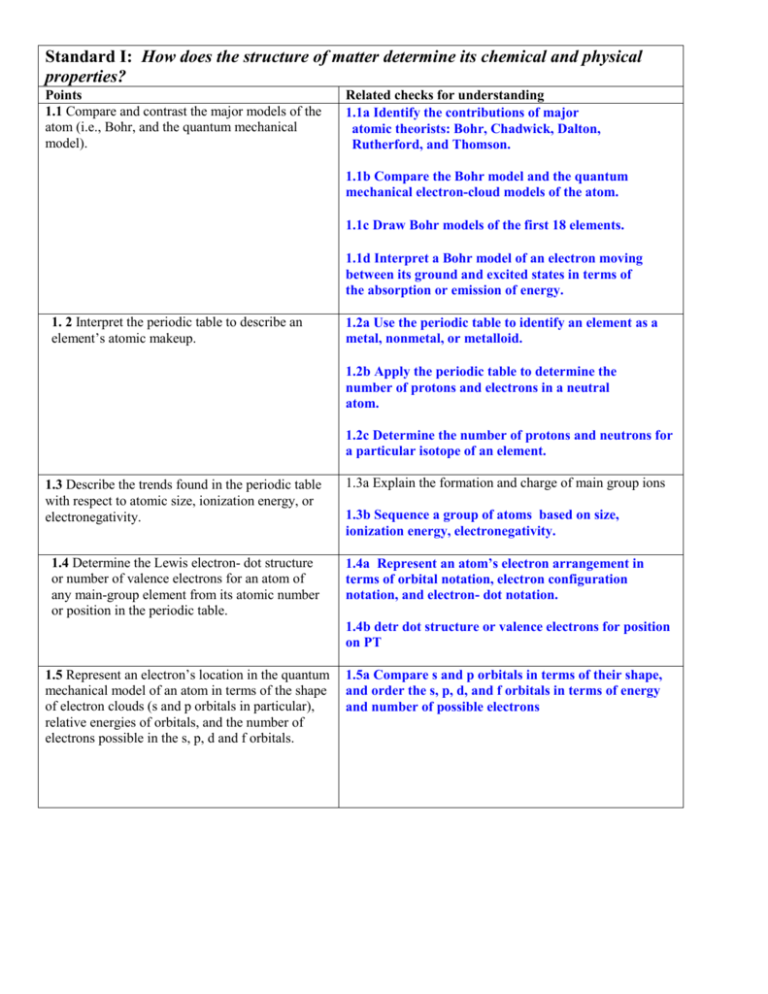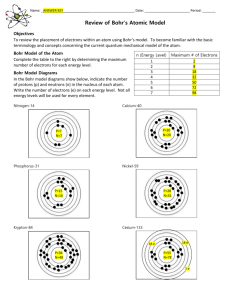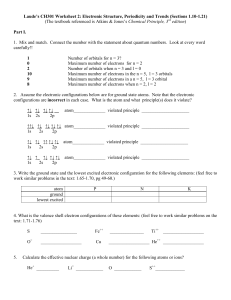Standard I: How does the structure of matter determine its chemical
advertisement

Standard I: How does the structure of matter determine its chemical and physical properties? Points 1.1 Compare and contrast the major models of the atom (i.e., Bohr, and the quantum mechanical model). Related checks for understanding 1.1a Identify the contributions of major atomic theorists: Bohr, Chadwick, Dalton, Rutherford, and Thomson. 1.1b Compare the Bohr model and the quantum mechanical electron-cloud models of the atom. 1.1c Draw Bohr models of the first 18 elements. 1.1d Interpret a Bohr model of an electron moving between its ground and excited states in terms of the absorption or emission of energy. 1. 2 Interpret the periodic table to describe an element’s atomic makeup. 1.2a Use the periodic table to identify an element as a metal, nonmetal, or metalloid. 1.2b Apply the periodic table to determine the number of protons and electrons in a neutral atom. 1.2c Determine the number of protons and neutrons for a particular isotope of an element. 1.3 Describe the trends found in the periodic table with respect to atomic size, ionization energy, or electronegativity. 1.4 Determine the Lewis electron- dot structure or number of valence electrons for an atom of any main-group element from its atomic number or position in the periodic table. 1.3a Explain the formation and charge of main group ions 1.3b Sequence a group of atoms based on size, ionization energy, electronegativity. 1.4a Represent an atom’s electron arrangement in terms of orbital notation, electron configuration notation, and electron- dot notation. 1.4b detr dot structure or valence electrons for position on PT 1.5 Represent an electron’s location in the quantum mechanical model of an atom in terms of the shape of electron clouds (s and p orbitals in particular), relative energies of orbitals, and the number of electrons possible in the s, p, d and f orbitals. 1.5a Compare s and p orbitals in terms of their shape, and order the s, p, d, and f orbitals in terms of energy and number of possible electrons Standard II: The properties of matter determine how it interacts with energy. Points 2.1 Distinguish among elements, compounds, and mixtures. 2.2 Identify properties of a solution: solute and solvent in a solid, liquid or gaseous solution; procedure to make or determine the concentration of a solution in units molarity, percent composition, factors that affect the rate of solution. Related checks for understanding 2.1a Identify a material as an element, compound or mixture; identify a mixture as homogeneous or heterogeneous 2.2a Identify the solute and solvent composition of a solid, liquid or gaseous solution. 2.2b Express the concentration of a solution in units of molarity, molality, and percent composition. 2.2c Describe how to prepare solutions of given concentrations expressed in units of molarity, molality, and percent composition. 2.2d Describe how to prepare a specific dilution from a known molarity 2.2e Investigate factors that affect the rate of solution. 2.3 Classify a solution as saturated, unsaturated, or supersaturated based on its composition and temperature and a solubility graph. 2.4 Identify properties of matter (e.g., physical: density, boiling point, melting point, or chemical: ability to rust or tarnish, be sour) or changes in matter (e.g., physical: phase change, shape, color, or chemical: formation of a gas or precipitate). 2.5 Compare and contrast heat and temperature changes (endothermic / exothermic) in chemical (e.g., combustion) or physical (e.g., phase transformations) processes. 2.6 Investigate similarities and differences among solids, liquids and gases in terms of energy and particle spacing. 2.7 Predict how changes in volume, temperature, and pressure affect the behavior of a gas. 2.2f Solve colligative property problems involving FPD and BPD 2.3a Use a solubility graph to determine type of solution at a given temp 2.4a Classify properties/change as physical, chemical, or nuclear 2.5a Use calorimetry to: identify unknown substances through specific heat, determine the heat changes in physical and chemical changes, determine the mass of an object, and determine the change in temperature of a material. 2.5b Perform calculations on heat of solvation, heat of reaction, and heat of formation, and heat of phase change. 2.6a Use particle spacing diagrams to identify solids, liquids, or gases. Distinguish in terms of relative KE 6b use phase diagram to correlate changes in temp and energy with phases of matter 2.7a Use gas law equations involving volume, temperature, and pressure 2.7b graph and interpret results of exp that explore relationship between the above variables Standard III: Interactions between matter generate substances with new physical and chemical properties. Points 3.1 Analyze ionic and covalent compounds in terms of their formation (electron transfer versus sharing), names, chemical formulas (e.g., molecular: H2O, CO2, NH3; empirical: NaCl, CaBr2, Al(NO3)3), percent composition, and molar masses. Related checks for understanding 3.1a Determine the type of chemical bond that occurs in a chemical compound 3.1b Differentiate between ionic and covalent bond 3.1c Identify chemical formula of a compound 3.1d Use PAI chart to name and describe ionic compounds 3.2 Determine the reactants, products, and types of different chemical reactions: composition, decomposition, double replacement, single replacement, combustion. 3.3 Predict the products of a chemical reaction (e.g., composition and decomposition of binary compounds). 3.4 Balance a chemical equation to determine molar ratios. 3.5 Convert among the following quantities of a substance: mass, number of moles, number of particles, molar volume at STP. 3.6 Identify and solve stoichiometry problems which interconvert volume of gases at STP, moles, and mass. 3.7 Classify substances as acids or bases based on their formulas and how they react with litmus and phenolphthalein. 3.8 Describe radioactivity through a balanced nuclear equation and through an analysis of the half-life concept. 3.1e Use percent composition to determine empirical and molecular formula 3.2a Identify the types of reactions 3.3a Predict products given the reactants of a synthesis or decomposition reactions 3.3b Understand percent yield/error as it relates to the formation of product 3.4a Balance an equation understanding the significance of the coefficients as mole/atom ratios 3.5a Convert between mass, moles, molar volume, and number of particles Same as above 3.7a Predict products of a neutralization reactions 3.7b Relate to acidity/basicity to pH value and color change of indicators ie phenolphthalein and litmus 3.7c identify substance as acid/base from formula 3.8a Write a balanced equation involving alpha and beta particles 3.8b Perform half-life calculations using graph or data Standard IV: Misc Standards 4.1 Use a thermometer, balance, burette, and pipette appropriately 4.2 Distinguish between accuracy and precision 4.3 Calculate percent error 4.4 sig figs and metric conversions






